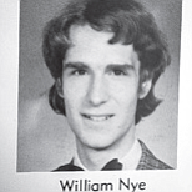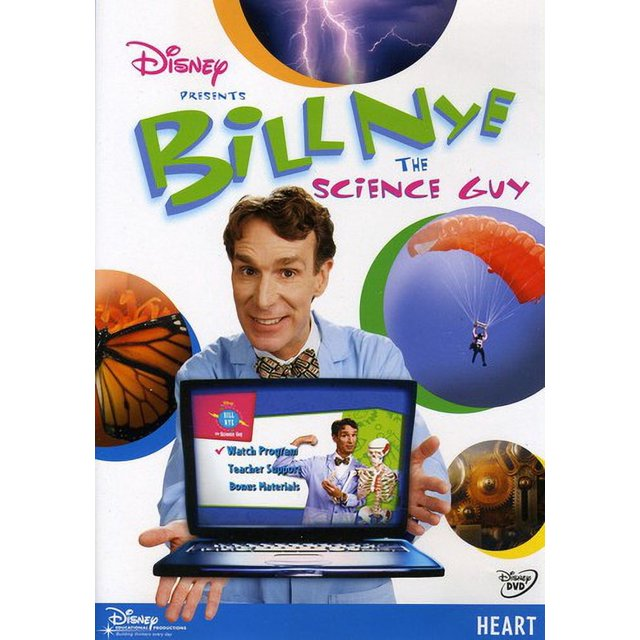Bill Nye the Science Guy
March 25, 2017 at 1:15 p.m. | Updated September 1, 2024 at 12:00 a.m.
Bill Nye has been a household name since his hit television show, Bill Nye the Science Guy (1993-1998). He has recently been in the local news because of a donation of artifacts he made to Seattle's Museum of History & Industry (MOHAI) from his tenure on the influential Seattle-based sketch comedy show, Almost Live! as well as his show, "Bill Nye the Science Guy."
Northwest Prime Time will take this opportunity to revisit a cover article on Bill Nye we published in April 2017. Information about his recent donation to MOHAI can be found at the end of the article. Enjoy.
William Sanford Nye was born in Washington D.C. in 1955, but the Science Guy got his start in Seattle.
Bill Nye is a scientist, engineer, comedian, author and inventor, but he is best-known as the Emmy award-winning television host of Bille Nye the Science Guy.
Bill’s mission is to help people understand and appreciate science. He has a knack for making science entertaining and understandable, combined with a zany flair for comedy.
"My family is funny," Bill reveals on his website (www.BillNye.com). "I mean funny in the sense that we make people laugh, not just funny looking."
In PBS’s NOVA series, The Secret Life of Scientists & Engineers, Bill explained how the unlikely pairing of Steve Martin and Carl Sagan was the catalyst for his successful Science Guy character.
“I loved science from when I can’t remember. When I was a kid, bicycles were just the coolest thing…Bicycles and airplanes,” interests that inspired him to study mechanical engineering at Cornell University.
“Our story begins when I was a senior in college. My friend came hurrying to my house. He wanted me to see Steve Martin performing on cable television. He said, ‘Look, this guy is just like you…This is what you ought to be doing!’” But Bill was focused on graduating and getting a job. He did get a job at Boeing and moved to Seattle (where he developed a hydraulic resonance suppressor for 747s).
But Steve Martin came up again about a year later. “When I was working for Boeing, I entered the Seattle Steve Martin look-alike contest, and I won.” He started performing as Steve Martin at parties and developed dual careers as an engineer by day and a stand-up comic by night. “After you get laughs on stage, it’s addicting,” he admits. He eventually quit his engineering day job to pursue comedy.
 When Bill was a young engineer at Boeing in Seattle, he won a Steve Martin look-alike contest. It was the catalyst for a career change to comedy and television
When Bill was a young engineer at Boeing in Seattle, he won a Steve Martin look-alike contest. It was the catalyst for a career change to comedy and television
Bill met Steve Wilson, one of the people launching Almost Live— Seattle’s homegrown ensemble comedy show that ended up going national. Wilson was interviewed for Popular Science about his buddy Bill. “Nye started hanging around the writers’ room. He’d make these jokes—we called them jokes of the future because they weren’t funny (yet). But Bill learned that if he dipped a marshmallow in liquid nitrogen and popped it in his mouth, smoke came out of his nose, which got laughs. He could entertain people using… science!”
Bill started writing for Almost Live and at the same time volunteered at the Pacific Science Center. “We were in a meeting for the show, and we had to fill six minutes,” he explained. The host, Ross Shafer said, ‘Bill, why don’t you do that stuff you’re always talking about at the Science Center. You could be, I don’t know, Bill Nye the Science Guy, or something.’ That’s how the first Science Guy bit came to be,” recalls Bill, who thought it was a fantastic idea.
The Seattle Times described The Science Guy’s inception this way: “In 1987, Nye conducted an experiment on Almost Live! that would hint at the Science Guy's awesome TV potential. Donning lab coat and safety glasses from his personal collection, he dunked an onion in liquid nitrogen and shattered it. The studio audience went nuclear. ‘It hit me so hard,’ Nye recalls. ‘Here was everything I wanted to do, with science and being funny, all at once.’ He won a local Emmy for the bit and, that same year, trademarked the Bill Nye the Science Guy name and printed up stationery and business cards that read comedian - actor - writer – engineer.”
Bill realized that The Science Guy had potential, and consulted his former astronomy professor, Carl Sagan, about it. “Sagan influenced me a great deal. Then at my 10th reunion, I met with him…I said I wanted to do a show about science for kids. He said, ‘Focus on pure science. Kids resonate to pure science.’” And if you want to entertain a kid, adds Bill, “you make it funny.”
Bill started developing the Bill Nye The Science Guy show with Seattle’s PBS television station, KCTS 9. The hit show was distributed by the Disney Company. Over the course of its five year run from 1993 to 1998, the show won 19 Emmy awards; Bill, himself, won seven.
 Bill Nye is the author of several books, and his DVDs are still shown in science classrooms around the country
Bill Nye is the author of several books, and his DVDs are still shown in science classrooms around the country
The New York Times called Bill Nye “The Bruce Springsteen of the Nerds.” He does come across a bit like a rock star on the college lecture circuit. “People in college grew up watching Bill Nye The Science Guy. They recite lines from the show…it’s really extraordinary,” he exclaims. Wherever he goes, he gets stopped for autographs, selfies, hugs and high-fives.
It’s the unique combination of science education, entertainment and comedy that sets Bill Nye apart. He comes by the comedy naturally, he says. “My family is funny,” he confides, “not just funny looking.”
His family is more than funny; they’re smart. “My grandfather was an organic chemist,” says Bill. As a kid, his father dubbed himself “Ned Nye, Boy Scientist,” although he made his living as a salesman. His father was also a lifelong sundial enthusiast, an interest he developed while in a Japanese prisoner-of-war camp. Bill’s mother played a role in WWII, too, as a code breaker. “My mom and her buddies worked on the Enigma code,” says Bill, something she had to keep secret for 50 years. His niece and nephew both have PhDs in chemical engineering.
Bill holds Honorary Doctorate degrees from six universities. He has lectured at his alma mater Cornell, where, as a tribute to his parents’ strong belief in the value of education, he designed and funded a 12-foot diameter clock to be installed in their honor. And, inspired by his father, he designed the MarsDials, three sundials mounted on the robotic rovers exploring Mars. So Bill made it to space, in a sense, even though he was rejected four times by NASA for the astronaut program.
Bill Nye’s other designs and inventions include a device to help people learn how to throw a baseball better, a magnifier made of water for science kits, a digital abacus and an improved ballet toe shoe.
Dancing is another of Bill’s passions. “I like dancing,” says Bill. “I go dancing all the time. Swing dancing, specifically. When I lived in Seattle, I used to go Scandinavian folk dancing and ballroom dancing.” He’d wanted to be on Dancing with the Stars for a long time, and his wish came true in 2013. But learning choreography “is a whole, completely different thing. I was very nervous,” he said of performing on the show. Unfortunately, he tore a quadricep early in the competition, an injury that left him walking with a cane. “When I got injured on Dancing with the Stars it was fantastically disappointing. But it was really this great experience,” he adds.
 Bill appeared on 'Dancing with the Stars' in 2013, but was soon sidelined because of an injury
Bill appeared on 'Dancing with the Stars' in 2013, but was soon sidelined because of an injury
In addition to dancing, Bill keeps fit with bicycling and rigorous calisthenics. Always active, he also founded the first men’s ultimate Frisbee team in Seattle, the Olympic Windjammers.
Bill remains a popular public figure and continues his role as a science educator. He serves as CEO of The Planetary Society, the world’s largest space-interest group. “The Planetary Society was started by Carl Sagan,” says Bill, who became a member in 1980. “I got on the Board of Directors, then I left the room or something and I became Vice President. And then, at a dinner party, there was wine or something. Now I’m the CEO!”
In 2004, Bill moved to Los Angeles for more opportunities, where he remains involved in a good-natured rivalry with his neighbor, actor and fellow environmentalist, Ed Begley. They compete to see who can save the most energy and produce the smallest carbon footprint. Bill now splits his time between Los Angeles and New York City. He remains committed to engaging the world about the dangers of climate change.
His television work continued after his Seattle-based mega-hit. His additional shows include The Eyes of Nye, Stuff Happens, and the 100 Greatest Discoveries show. Bill has even on occasion entered the acting fray, appearing on both TV and film. He is well-known for his educational children’s books and DVDs, which continue to be shown in science classrooms around the country. His general audience books include the bestseller Undeniable and Unstoppable: Harnessing Science to Change the World and Everything All at Once.
His Netflix show, Bill Nye Saves the World premieres on April 21, 2017, the day before Earth Day. It featured experts and famous guests for high-energy talk show exploring “hot” topics in science and technology. Watch the trailer at www.netflix.com/title/80117748.
While he was creating The Science Guy series, Bill wrote a rule book for the show. The first rule was to “Change the World.” Nye, who is single and never had children of his own, spent his life educating kids to like science. He wants more kids, especially girls, to study math, science and engineering to help make the world healthier for everyone. Through his work, Bill hopes to inspire people everywhere to change the world.
BOW TIES
Bill Nye says that the most common question he gets is, ‘How many bow ties do you have?’ The answer? Hundreds.
“I started wearing bow ties when I was young, in high school,” says Bill. The boys served the girls at a high school banquet; Bill told the guys they should look like waiters and wear bow ties. “I remember, my father showed me how to tie it while we were watching a Perry Mason rerun. What I found was that a bow tie does not slip into your flask or slip into your soup. It’s very practical.”
Bill started a line of bow ties with menswear designer Nick Graham. “Looking sharp is not rocket science,” says Bill
You can watch a You Tube video of Bill demonstrating how to tie a bowtie; just search “Bill Nye – tying a bow tie is not a rocket science.”
MUSEUM DONATIONS
Bill Nye's original lab coat from Bill Nye the Science Guy is on display at the "T is for Television" exhibit in the Smithsonian National Museum of American History.
Bill Nye's recent donations to Seattle's Museum of History & Industry (MOHAI) include artifacts from his tenure on the influential Seattle-based sketch comedy show Almost Live! and his popular TV show Bill Nye the Science Guy.
"This gift underscores MOHAI's commitment to preserving and showcasing the diverse history of Seattle and its surrounding communities. The addition of these iconic items enriches the museum's collection and provides a rare glimpse into the life of a beloved local personality," stated a MOHAI press release.
"We are thrilled to feature part of this exciting donation in the upcoming Almost Live! (Almost an Exhibit) and look forward to making other components available through our online database and future display opportunities," said MOHAI Executive Director Leonard Garfield.
Almost Live! (Almost an Exhibit) features costumes and props, interactive displays, and personal anecdotes from the cast and crew. This immersive experience is meant to provide visitors with a deeper understanding of the show's legacy and its role in shaping Seattle's identity.
For more information about the Almost Live! exhibit and Bill Nye donations, visit www.MOHAI.org.





